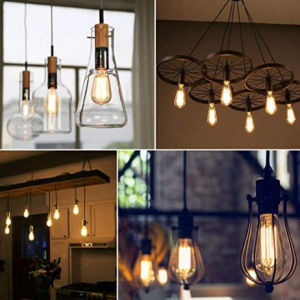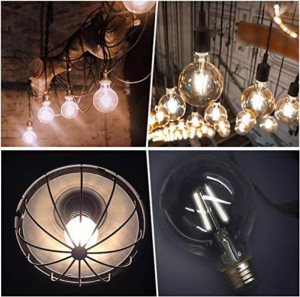LEDs are known for their low power consumption and high brightness. Brightness and energy consumption are more than 60% different from traditional tungsten bulbs. But not all bulbs are dimmable, and the price of dimmable bulbs will be more expensive, you will need to assess your needs before choosing your LED lights. This is especially important when replacing older lighting with newer LED technology for the first time and expect them to dim.
Are my Edison bulbs dimmable?
A dimmable light bulb is a light bulb that can adjust the brightness of the light according to customer requirements, thereby affecting the brightness of the indoor light and bringing out different indoor environment atmospheres.
If you bought a finished LED fixture or bulb, check to make sure the packaging specifically states that it is dimmable. This should be stated in the description or the technical specifications of the light. If you use a non-dimmable LED on a dimmer you will get a lot of flickering and damage the bulb, limiting it’s lifespan. A symbol similar to below is sometimes used to show a light is dimmable, unfortunately there is no specific universal symbol.
Usually whether a light bulb can be dimmed can be seen on the packaging of the light bulb, and dimmable light bulbs are also more expensive than non-dimmable light bulbs. Dimmable light bulbs can adjust the brightness of the light according to customer requirements, thereby affecting the brightness of the indoor light and bringing out different indoor environment atmospheres, saving energy and reducing carbon emissions. More and more consumers tend to buy dimmable light bulbs.
LED Edison bulb dimming principle:
As a constant current source, LEDs are inherently dimmable. The current flowing through the LED lamp bead determines the light output”. Their brightness can be adjusted simply by controlling the energizing current of the semiconductor material layer attached to the substrate. LEDs are not like traditional light sources, and dimming does not affect Efficiency and lifetime of LEDs. In fact, dimming can reduce their operating temperature, thereby prolonging the life of LEDs. Any LED device, if it is to be made into a replacement light source or LED lamp, requires a driver to achieve dimming. Because LEDs are It is a low-voltage DC source, and the LED needs an electronic driver to convert the AC into a usable and adjustable DC current.These drivers are divided into three dimming methods.
In pulse width modulation (PWM) mode, the current through the LED is switched on and off at a very high frequency, “typically thousands of times per second”, and the current through the LED is equal to the average value of the current during the LED switching cycle. “By reducing the power-on time of the LED, the average current or effective current can be reduced, thereby reducing the brightness of the LED. Like traditional light sources, LEDs can also be dimmed by constant current reduction (CCR), or analog dimming. CCR keeps the light source There is continuous current, but dimming is achieved by reducing the magnitude of the current. “The light output is proportional to the current through the LED device,”
Both PWM and CCR have advantages and disadvantages. PWM is more widely used and has a wider dimming range. Because PWM dimming uses fast switching on and off, it requires more complex and expensive electronic drive equipment to generate current pulses of high enough frequency to prevent human eyes from detecting them. flickering. The CCR dimming method is more efficient and simple, because the driving equipment it requires is simpler and cheaper. Unlike PWM, CCR does not generate electromagnetic interference EMI caused by high frequency switching. However, CCR is not suitable for applications where the dimming requirement is less than 10%. “At very low currents, the LEDs did not work properly and the light output was unstable.
LED Silicon controlled rectifier power supply has been used in the dimming of incandescent lamps and energy-saving lamps earlier, and it is also the most widely used dimming method for LED dimming. Silicon controlled rectifier is a kind of physical dimming. Its working principle is to generate a tangential output voltage waveform after the waveform of the input voltage is cut by the conduction angle. Applying the tangential principle can reduce the effective value of the output voltage, thereby reducing the power of the common load (resistive load). Silicon controlled rectifier dimmers have the advantages of high adjustment accuracy, high efficiency, small size, light weight, and easy remote control. The adjusted light is soft and stable, and there will be no stroboscopic phenomenon. dominate the market. The advantages of Silicon controlled rectifier dimming are high working efficiency, stable performance and low dimming cost.
The three-stage dimming of our products adopts silicon controlled rectifier power supply.
Dimmable light bulb usage scenarios:
Dimmable light bulbs are used in a variety of scenes, such as hotels, dance halls, venues, exhibition halls and other occasions that require lighting, mainly by changing the amount of light source to adjust the brightness of the lighting. Now that the atmosphere is getting warmer, the issue of how to reduce electricity consumption for lighting is also imminent. Fortunately, the emergence of LED lights saves a lot of energy. It would be even better if regulation could be used to save energy more effectively. For the dimming of LED bulbs, such as home wall lamps, offices, shopping malls, schools, factories and other occasions can be adjusted according to the required lighting, and energy saving effects can be achieved. If these occasions are replaced with adjustable LED bulbs, it will save a lot of energy.


Dimmable lighting gives you the flexibility to match the lighting around you to your activity. You may want a bright light when working on the checkbook but a dim relaxing light when eating in the evening. Dimming has also been used more within the commercial and industrial environments. Adding dimmable lighting offers flexibility to your office space and allows for optimal lighting for your employees preferences or needs. Whether you are meeting guests, watching TV, listening to music, with your family, or thinking alone, you can adjust the brightness of different lights to create a comfortable, quiet, harmonious, and warm atmosphere, and a deeper experience of life. Soft light can bring a good mood, less and dark light can help thinking, more and bright light can make the atmosphere more warm. All complex needs can be met through the simplest operation, and only need controlled by normal switches to adjust the light and dark brightness of different areas.
Post time: Jan-13-2023









